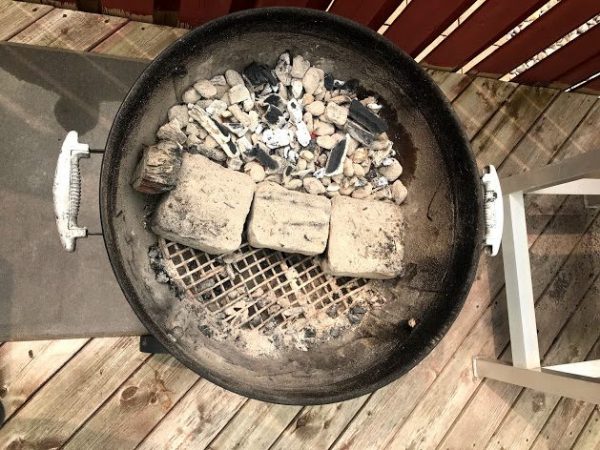Shashlik is a skewered meat that is marinaded in an acidic marinade similar to a shish kabob from Eastern Europe. I first had chicken shashlik while visiting Latvia, and became my favourite dish to eat while I was there. I spent a lot of time trying to recreate the dish on my own, and came up with a dish that tastes very similar.
You can use this marinade with chicken, pork, beef, lamb, or any meat that is sturdy enough to hold up to being skewered, and grilled. Something delicate like fish likely wouldn’t work well.
Typically, shashlik is cooked on a mangal, which is an style of grill that doesn’t have a lid. I’ve used a charcoal kettle grill to reproduce the result. You can use a gas grill to cook the shashlik, but you may need to use medium-low heat to prevent the meat from overcooking, and drying out. Or, you can skip the skewering, and grill as you would chicken.
I set up my charcoal kettle to use a 2-zone heating method. The charcoal is constricted to one side of the grill, while the other side remains cooler. This allows the chicken to cook via indirect heat.
Print Recipe
Chicken Shashlik
Yum
A favorite that brings back memories of my trip to Latvia.
Instructions
Marinade the chicken
As with most of my recipes, I gather all of the required ingredients together before starting, so I don't have to look for things while I am working.
Roughly chop up the onions, and garlic, and add them to a food processor, or a blender. I use an immersion blender and a container large enough to hold at least a litre. You may have to work in batches if you don't have a large enough container..
Add the vinegar, and chicken stock, and pulse/blend until the contents are mostly liquefied.
Add the lemon juice, pepper, oregano, salt, and bay leaves and continue to blend.
Once blended, pour into the container you will be using to marinade the chicken in. I use a zipper sealing bag to contain all of the mess, and to keep all the chicken in the marinade.
Allow the chicken to marinade in the fridge for 12 to 36 hours. Stirring, or mixing, or flipping the bag occasionally.
Preparing skewers
Metal skewers are preferable, but if you are using wooden skewers, soak them in water for 30 minutes before skewering the chicken.
If using a zipper sealed bag, pour the contents into a large work bowl.
Skewer the chicken, folding the thighs in half, so each thigh is skewered twice. This will help hold the chicken on the skewer.
Continue to skewer the chicken, packing the chicken tightly together, this will help in keeping the chicken from drying out, and burning.
Grilling over charcoal
Light the charcoal and spread it evenly over half of the charcoal grate. I find it easier to grill the skewers without the top grate, but if you are using smaller skewers, you may need the top grate to hold the chicken.
Place the skewered chicken over the hot coals.
Cover the grill, and allow to cook for 10 minutes, or until the chicken begins to brown. Don't let it get burned though.
Flip the skewers and cook the second side of the skewers for 10 minutes until they brown. Covering the grill again.
Move the skewers to the cooler side of the grill, and cover, allowing the chicken to cook via indirect heat. Rotate the skewers and change their positions every 15 to 20 minutes to avoid some of the skewers from cooking faster than the others.
Once the chicken reaches 175 degrees, remove them from the grill, and allow to rest for a few minutes before serving. The metal skewers will be hot, be careful.They should cook in about an hour, depending on the heat of the grill.
Grilling on a gas grill
Light the grill to medium-low to medium, and allow it to heat up.
Grill the skewers, flipping the chicken every 10 to 15 minutes, until the chicken reaches 175 degrees. This should take 30 to 45 minutes, depending on the heat of your grill.
Searving
If you are using large skewers, leave the chicken on the skewers to serve, sliding the chicken off of the skewers on to peoples plates at the table. If using shorter, you can either remove the meat on to peoples plates, or serve the entire skewer.
Recipe Notes
With this recipe, you are marinading the chicken in an acidic marinade for a prolonged period of time. This is different than most acidic marinades which tend to be shorter because the texture of the meat changes. This change in texture is desired, and marinading the chicken for a couple of days isn't uncommon.


























